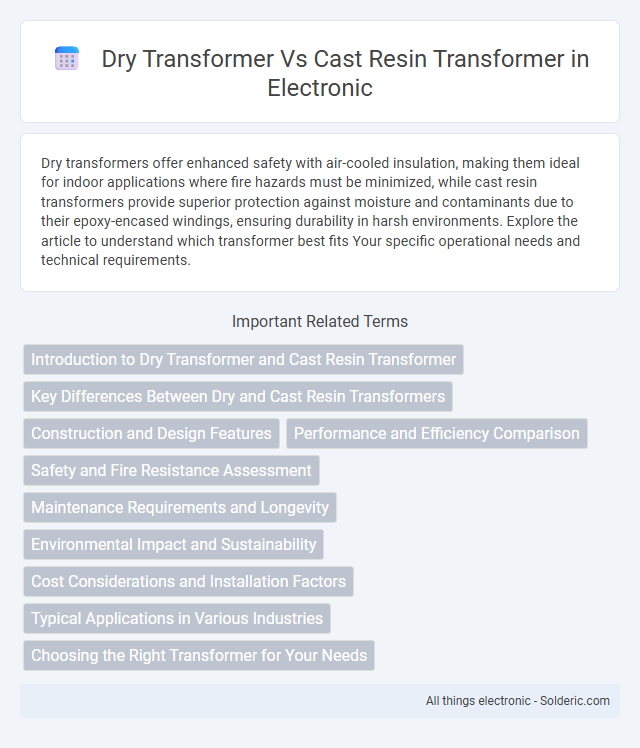Dry transformers offer enhanced safety with air-cooled insulation, making them ideal for indoor applications where fire hazards must be minimized, while cast resin transformers provide superior protection against moisture and contaminants due to their epoxy-encased windings, ensuring durability in harsh environments. Explore the article to understand which transformer best fits Your specific operational needs and technical requirements.
Comparison Table
| Feature | Dry Transformer | Cast Resin Transformer |
|---|---|---|
| Insulation Type | Air-cooled, epoxy or silicone resin coated windings | Epoxy resin encapsulated windings |
| Cooling Method | Natural air circulation or forced air | Natural air cooling due to resin encapsulation |
| Moisture Resistance | Lower, sensitive to humidity | High, excellent moisture and dust resistance |
| Maintenance | Requires periodic cleaning and checks | Minimal maintenance due to sealed construction |
| Fire Safety | Good, less flammable materials | Superior fire resistance, self-extinguishing resin |
| Application | Indoor use, dry environments, industrial | Harsh environments, outdoor and wet areas |
| Lifespan | 15-25 years depending on conditions | 20-30 years with enhanced durability |
| Cost | Generally lower initial cost | Higher initial cost due to resin encapsulation |
Introduction to Dry Transformer and Cast Resin Transformer
Dry transformers use air or epoxy resin to insulate the windings, making them suitable for indoor environments with stringent fire safety requirements. Cast resin transformers encapsulate the windings fully in epoxy resin, providing superior moisture resistance and durability in harsh or outdoor conditions. Understanding the differences in insulation and application helps you select the right transformer for reliable performance and longevity in your electrical systems.
Key Differences Between Dry and Cast Resin Transformers
Dry transformers use air as the primary cooling medium and feature windings encapsulated with varnish, offering good heat dissipation and maintenance ease. Cast resin transformers encapsulate windings in epoxy resin, providing superior insulation, moisture resistance, and enhanced safety in hazardous environments. Your choice depends on factors like operating conditions, environmental exposure, and maintenance preferences.
Construction and Design Features
Dry transformers feature air-cooled windings encapsulated in epoxy resin or varnish, offering high thermal stability and flame resistance. Cast resin transformers utilize vacuum pressure impregnation (VPI) to encase windings in solid cast epoxy, enhancing moisture resistance and reducing the risk of short circuits. Both designs prioritize electrical insulation and durability, with cast resin models typically providing superior protection in harsh or humid environments.
Performance and Efficiency Comparison
Dry transformers offer high thermal stability and are ideal for environments requiring fire resistance, while cast resin transformers provide superior insulation and enhanced moisture resistance. Cast resin transformers generally exhibit lower dielectric losses and improved energy efficiency due to their robust construction, leading to lower operational costs over time. Performance-wise, cast resin transformers are better suited for harsh environments, whereas dry transformers excel in applications demanding easy maintenance and reduced environmental impact.
Safety and Fire Resistance Assessment
Dry transformers offer enhanced safety features due to their air-cooled insulation system, significantly reducing the risk of fire compared to oil-filled alternatives. Cast resin transformers use a solid epoxy resin to encapsulate the windings, providing superior fire resistance and eliminating flammable liquids, which makes them ideal for environments with strict fire safety regulations. Your choice between these types should consider the required fire safety standards and operational environment to ensure optimal protection.
Maintenance Requirements and Longevity
Dry transformers generally require more frequent maintenance due to their exposure to environmental factors like dust and moisture, which can affect insulation and cooling performance. Cast resin transformers offer superior longevity with minimal maintenance needs because their resin-encapsulated coils provide excellent protection against contaminants and moisture. Your choice impacts maintenance schedules and operational lifespan, with cast resin transformers being ideal for environments demanding durable, low-maintenance solutions.
Environmental Impact and Sustainability
Dry transformers produce less environmental pollution due to their use of air cooling instead of oil, eliminating the risk of oil leaks and soil contamination. Cast resin transformers offer enhanced fire safety and lower maintenance requirements, contributing to longer service life and reduced waste. Selecting your transformer based on environmental impact supports sustainable energy infrastructure by minimizing ecological footprint and promoting safer disposal practices.
Cost Considerations and Installation Factors
Dry transformers generally have lower initial costs compared to cast resin transformers, making them a budget-friendly option for many applications. Installation of dry transformers is simpler and faster due to their lighter weight and compact design, reducing labor expenses and site preparation time. Your choice should consider the balance between upfront investment and long-term operational needs, including space constraints and environmental conditions.
Typical Applications in Various Industries
Dry transformers are commonly utilized in commercial buildings, hospitals, and schools where fire safety is critical due to their non-flammable insulation materials. Cast resin transformers find extensive use in industries such as mining, chemical processing, and offshore oil platforms because of their superior resistance to moisture, dust, and corrosive environments. Selecting the appropriate transformer impacts your electrical system's reliability and compliance with industry-specific safety standards.
Choosing the Right Transformer for Your Needs
Dry transformers offer excellent thermal performance and are ideal for indoor environments where fire safety and low maintenance are priorities. Cast resin transformers provide superior insulation and moisture resistance, making them suitable for harsh or outdoor conditions with higher safety requirements. Your choice depends on environmental factors, installation constraints, and specific application needs to ensure optimal efficiency and longevity.
dry transformer vs cast resin transformer Infographic

 solderic.com
solderic.com